The optimal type of displacement boat
The efficiency of a slow-moving boat with an automobile engine is always higher than that of a planing one. Can a displacement boat with an automobile engine achieve the efficiency of a modern subcompact?
The experience of operating boats with a displacement of 1.5-2 tons, equipped with four-stroke engines and designed for tourist sailing with a crew of 3-4 people, often confirms that fuel consumption of about 10 liters per 100 km is quite real. However, in practice, it is possible to achieve high efficiency of a displacement boat only under the following conditions: the correct choice of the contours of the hull and the corresponding speed of movement, the installation of an economical engine and the choice of its operating mode, the selection of the optimal screw and its correct location relative to the hull, i.e. with the correct solution of a whole set of tasks.
For the most slow-moving and seaworthy boats, the hull with a sharp stern of the whaleboat or cruising type is optimal (see, for example, the book by X. Baader «Traveling, sports and tourist boats», L., «Shipbuilding», 1976). The appropriate speed limits for boats of this type are 9 km/h with a hull length of 6 m and 10 km/h with a length of 7.5 m. If these speed values are exceeded, the running trim of the boat and the water resistance to its movement will increase, the required engine power and fuel consumption for each kilometer traveled will increase. Therefore, for boats designed for displacement navigation with slightly higher speeds than indicated above, the contours of the hull with a transom stern become optimal. The wide and full stern creates a lifting force that prevents the occurrence of excessive running trim. For the displacement mode of navigation, it is sufficient that the recess of the transom is 0.2-0.25 of the draft of the hull amidships.
The graph shown in Fig. 1 gives a visual representation of the relationship between speed, displacement, hull length along the waterline, water resistance and fuel consumption (in liters per 100 km of distance traveled) for boats with transom stern, on which engines with a specific fuel consumption of 250 g/ hp are installed. It is assumed that the propeller the screw has parameters allowing to obtain a total propulsive efficiency equal to 0.5.
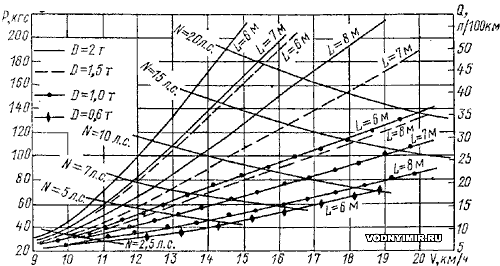
Fig. 1. Change in resistance (P, kgf), required power (N, hp) and fuel consumption (Q, l/100 km) depending on speed (V, km/h), displacement (D, t) and length by KVL (L, m) displacement boat.
Analyzing the graph, it can be established that for most boats the optimal speed (in terms of fuel consumption) is 9-11 km/h. A boat with a displacement of up to 2 tons can reach this speed with an engine power of only 2.5-3 hp. For heavy and short boats (D=1.5-2 tons; L=6-7 m), a slight increase in speed compared to the optimal one (by only 2 km/h) increases fuel consumption by 2 times, i.e. by 10-15 liters for every 100 km. Reducing the speed by 2 km/h reduces fuel consumption by only 3-4 liters.
For light and long boats, satisfactory fuel consumption can be obtained at higher speeds — 18-20 km/h.
Although the required engine power is only 2.5-3 hp for sailing a boat at an economic speed, it is irrational to install such an engine — a reserve of power is needed for sailing in severe meteorological conditions. At the same time, the following should be taken into account: if the power removed from the engine is less than 1/3 of the nominal, then the efficiency of its operation is reduced. Fuel consumption when the engine is running at partial power can be estimated according to the schedule shown in Fig. 2.
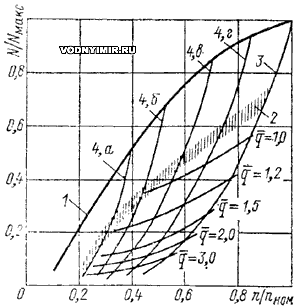
Fig. 2. Generalized characteristics of four-stroke carburetor engines:
Nmax — maximum engine power (hp); nnom — the speed corresponding to the maximum engine power (rpm). 1 — relative external characteristics of the engine; 2 — the area of minimum specific fuel consumption; 3 — boat characteristics with a normal screw; 4 — boat characteristics with heavy screws; isolines of relative specific costs (q) show how many times the specific consumption on this line is greater than the specific consumption at maximum power.
Let's explain with an example how to use this graph. Suppose a boat with a length of 6 m (D=1.5 t) has an 8 hp engine that develops 3000 rpm and has a specific fuel consumption of 320 g/hp h. If an optimal propeller is used, then with the throttle fully open, the engine will develop 3000 rpm; the speed of the boat will be 12.5 km/h (fig. 1), fuel consumption — 23 liters for every 100 km. But since the graph is built for engines with a specific flow rate of 250 g/hp h, the actual flow is proportionally equal to: Q=23x320/250=29.5 l/100km.
If the throttle valve is closed, the operating mode of the engine changes according to the screw characteristic. For displacement boats in the speed range of 10-15 km/h, the screw characteristic relates the power and the rotational speed by dependence:
N/Nmax=(n/nnom)3,5
Considering that 2.5 hp (power of the economy mode) is 31% of the maximum engine power equal to 8 hp, according to curve 3 (for the optimal screw) we find that the ratio of the rotational speed
n/nnom = 0.71,
and an increase in specific fuel consumption due to the engine running at partial power q=1.4. Thus, fuel consumption at N=2.5 hp and V=10 km/h will be: Q=9x320/250x1,4=16.1 l/100 km. At the same time, the engine will develop: n=3000x0,71=2130 rpm.
The calculations of fuel consumption given here and below are approximate, since the features of the contours of the boat, the brand of the engine, its wear, etc. are not taken into account. The actual consumption can vary by one and a half or more times. However, these calculations allow us to visually assess the impact of one or another efficiency factor and, consequently, to choose the optimal operating modes of the engine, speed, propeller, etc.
From fig. 2 it can be seen that efficiency can be improved if a heavier screw is installed. For example, in order to enter the range of optimal values of specific fuel consumption at the ratio N/Nmax=0.31, the engine must develop at the ratio n/nnom=0.38-0.45n=1140-1290 rpm.
This area is close to the screw characteristic 4B. According to this characteristic, it can be determined that if the throttle is fully open, the engine will develop only 1650 rpm (nmax/nnom =0.55), which corresponds to a power of 5.52 hp (Nmax /N=0.69). The maximum speed with a heavy propeller will decrease to 11.3 km/h, however, fuel consumption will also decrease: Q=9x320/250x1,02=11.7 l/100 km.
If the main goal is to increase the efficiency of boat operation, then the pitch of the screw should be chosen in such a way that the operating mode of the motor at economical power is in the area of minimum specific fuel consumption, i.e. that the screw is obviously heavy. If it is necessary to have an increased margin of speed (for example, to constantly overcome a strong oncoming current, etc.), the screw is calculated to operate the engine at the maximum point of the screw characteristic. On the other hand, it is impractical to use excessively heavy screws, since with a small error in determining the parameters of the screw, as well as when the boat is overloaded, the engine will work according to the external characteristic, which is undesirable from the point of view of reducing the engine life and its efficiency. In addition, when the engine is turned on at low speeds, the engine with an excessively heavy screw, as a rule, stalls.
The correct selection of the screw is checked by the number of revolutions nmax at maximum throttle opening — the ratio for heavy screws should be at least 0.4-0.5.
The most suitable engine for boats with a displacement of up to 2 tons would be an engine of the type UD 15V, developed almost 15 years ago (see «Boats and yachts» No. 15 for 1968). Unfortunately, this light and economical (specific consumption 230 g/hp h) engine was never launched in serial production. Data on other engines that can be installed on self-built boats are given in the table.
Main characteristics of four-stroke engines for displacement boats
| Engine brand | Power, hp | Rotation speed, rpm | Number of cylinders | Specific consumption, g/hp h. | Weight, kg | Cooling | Application | Note |
| UD1 | 4 | 3000 | 1 | 370 | 68 | Air. | Open vodoizm. boats | See. «Boats and yachts» No. 37 |
| UD15 | 4 | 3000 | 1 | 320 | 41 | Air. | See. «Boats and yachts» No. 37 | |
| L3 | 3 | 2200 | 1 | 335 | 72 | Watermark | Discontinued | |
| ud2 | 8 | 3000 | 2 | 330 | 90 | Air. | Cabin boats displacement. less than 2 t. | See. «Boats and yachts» No. 37 |
| Ud25 | 8 | 3000 | 2 | 320 | 52 | Air. | See. «Boats and yachts» No. 37 | |
| L6 | 6 | 2200 | 2 | 335 | 92 | Watermark | Discontinued | |
| L12 | 12 | 2200 | 4 | 335 | 147 | Watermark | Heavy boats displacement. more than 2 t. | Discontinued |
| UD4 | 16 | 3000 | 4 | 400 | 125 | Air. | Discontinued | |
| P23-M | 19 | 2500 | 2 | 320 | 180 | Watermark | Starting tractor engine | |
| MEMZ-966A | 30 | 4200 | 4 | 260 | 80 | Air. | Boats are elevated. high speed- news |
Automotive engine |
| MEMZ-968 | 40 | 4400 | 4 | 260 | 90 | Air. | ||
| MZMA-408 | 50 | 4700 | 4 | 240 | 146 | Watermark |
Even the most low-power car engines turn out to be very uneconomical when operating at partial (2-5 hp) power. With an increase in the speed of a slow-speed boat with an automobile engine, fuel consumption increases slightly, since with an increase in power, the efficiency of the engine improves.
So, for a boat with a length of 6 m and a displacement of 1.5 tons, on which the MZMA-408 engine is installed, after performing calculations like the example above, we will find the following fuel consumption values at different speeds of the boat:
| Speedv, km/h | Removable power N, hp | Fuel consumption Q, l/100 km |
| 10 | 2,5 | 9x2,6x240/250=22.5 |
| 12 | 6,5 | 20x1.4x240/250=26.8 |
| 14 | 12,5 | 33x1,1x240/250=34.8 |
When installing two-stroke engines, the most affordable of which are outboard motors «Breeze» and stationary outboard motor SM-557L, the indicators are much less economical. Due to the increased power, low efficiency and small diameter of the propeller, fuel consumption on a boat with a SM-557L engine at an economical speed is 2.5 times higher than the minimum that can be obtained when installing a four-stroke engine.
For a boat with a «Breeze» engine, fuel consumption increases already 3-3.5 times, and this motor, when installed on a displacement boat, practically has no traction reserve. For example, when installing the «Breeze-8» on the boat «Onega» or «Trout» with 1-2 people. on board, you can reach a speed of 9 km/h. At the same time, fuel consumption is 2.5-3 times more, and oil is 25 times more than that of a heavy displacement boat with an automobile engine, whose economic speed is also 1-3 km/h higher.
As a rule, a diesel engine with equal power consumes on average 30% less fuel (by volume) than a carburetor engine. Therefore, abroad, especially recently, single-cylinder diesels with a capacity of 6-8 hp and a weight of 50-80 kg have become widespread. A displacement boat with such an engine consumes about 7 liters per 100 km at an economical speed .
Of the low-power domestic diesel engines for installation on displacement boats, the most suitable are marine engines of the 2CHSP 8.5/11 (or 9.2/11) family with a power of 12-17 hp with a rotation speed of 1500-1900 rpm and a mass with a reverse gear of 295 kg; D21 air-cooled tractor engines with a power of 20-25 hp with a rotation speed of 1600-2000 rpm and weight (without clutch) — 280 kg. However, the power of these engines exceeds the optimum for boats of this type, so fuel consumption at an economical speed is 11-13 liters per 100 km, i.e. almost the same as when installing the UD 25 engine. Nevertheless, the diesel engine installation has a significant reserve of power, which allows you to operate the boat more confidently in stormy conditions and on the current, it is less fire-hazardous.
The above considerations about the efficiency of engines of various types are valid only for a serviceable engine. It should be remembered that incorrect adjustment of the ignition, valve mechanism, strong carbon formation, ignition interruptions can increase fuel consumption by 10-20%, and the "voracity" of a worn-out engine can be 1.5 times higher than that of a new one.
Special attention is also required for the selection of the optimal propeller, the elements of which differ significantly from the propellers of planing boats. The low speed of the boat forces the use of screws of a sufficiently large diameter, despite the low power. For example, for a 2.5-horsepower engine, the diameter of a sufficiently effective screw is 400 mm with a step of 250-280 mm and a rotation speed of 750 rpm. In this case, it is possible to obtain a screw efficiency of about 60% and the total propulsive coefficient of the propulsion system = 50%. These figures were taken as the initial ones when drawing up the graph Fig. 1.
For the efficient operation of large-diameter screws at reduced speeds, the installation of a gearbox is required. So, for the UD25 engine, the gear ratio of the gearbox with a heavy screw should be 1.8, with a normal one — 3. You can use a gearbox from the SM-557L engine, transmissions from passenger cars, etc.
Increasing the speed of the screw reduces its design efficiency and, consequently, efficiency. Thus, with an increase in the rotational speed from 750 rpm to 1500 rpm (the diameter of the screws will decrease to 290 m), fuel consumption at an economical speed should increase by 1.2 times, and with an increase in the rotational speed to 3000 rpm (screw diameter 200 mm) — by 1.5 times.
It is also important to ensure a normal flow of water to the screw, without interference from the thick beam of the stem, the propeller shaft brackets, etc. A large-diameter screw, a steering wheel and a well-streamlined deadwood, the correct choice of the distances of the deadwood to the edges of the screw are also mandatory conditions for obtaining high efficiency.
Large-diameter propellers allow you to get a large emphasis on mooring, which is important for displacement boats with low-power engines that are sensitive to strong headwinds. The aerodynamic drag at a headwind speed of 15 m/s is of the same order as the drag of a boat on an economical course. Under these conditions, the engine power reserve with a small diameter screw may not be enough even to maintain the minimum speed at which the boat is still controlled.
As a rule, displacement boats are characterized by high seaworthiness, high load capacity. On such boats, during the voyage, it is possible to create sufficiently comfortable conditions, which allows you to increase the daily mileage, which can be compared with the same indicator of a planing boat (see «Boats and yachts» No. 86).
Unfortunately, all the advantages of a displacement boat cannot always compensate for its main disadvantage — low speed. Analyzing the possibilities that domestic stationary engines provide to amateurs, the authors developed the concept of a displacement boat of increased speed, developing a speed of 15-18 km/ h with acceptable efficiency of operation. In our opinion, one of the main conditions that such a boat must meet is the relatively small mass of the vessel in the equipped state, it should not exceed 1300-1400 kg. Accordingly, the body weight should be limited to 600-700 kg. To reduce the wave resistance, the length of the hull along the waterline should be taken as maximum (the optimal length according to KVL L=8.5-9.0 m), to reduce the friction resistance, the wetted surface of the hull should be minimal, It follows that the boat should be narrow and long, the L/B ratio should be 6-8.
In the proposed project of the boat «Ples», the ratio of length by KVL to width is assumed to be 5. Fuel consumption of such a boat will be 40-50% more than with the optimal ratio of dimensions, however, reducing the length will facilitate the construction and storage of the boat.
The width of the hull along the waterline is 1.5 m, it turns out to be insufficient to create comfortable conditions for the crew of 3-4 people to travel, so the contours are chosen double-hull, with a maximum hull width above 2 m KVL.
The general location and appearance of the boat «Ples»
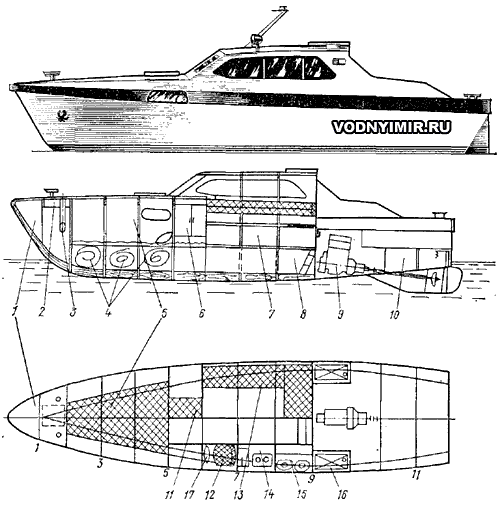
1 — forepeak, access from the cabin through the hatch; 2 — niche for anchor cables, has a drain overboard; 3 — anchor clews (pipes); you can give anchor without going on deck; 4 — supply compartments; 5 — cabin; 6 — closet for weekend clothes; 7 — dining area with a folding table; under the L-shaped sofa trunk (saved, vests); 8 — waterproof bulkhead; 9 — engine; 10 — afterpiece; 11 — seat, under it a radiator with a fan; 12 — driver's seat, next to the sink; 14 — gas stove; 15 — wardrobe for work clothes (has a drain overboard, radiator and fan); 16 — fuel tanks with a capacity of 100-150 liters; 17 — boat control panel.
| Basic data of the boat «Ples» | |
|---|---|
| Longest length, m | 8 |
| KVL length, m | 7,5 |
| Overall width, m | 2 |
| KVL width, m | 1,5 |
| Draft by hull, m | 0,3 |
| Overall draft, m | 0,6 |
| Estimated load capacity, kg | 500 |
| Maximum load capacity, kg | 1300 |
| Number of beds | 4-5 |
Theoretical drawing of the boat «Ples»
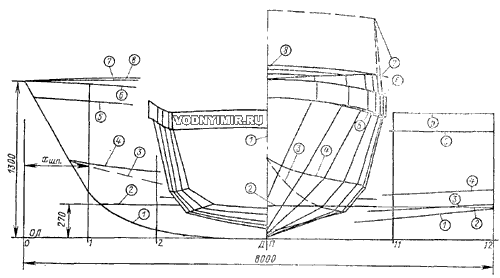
Table of plaz ordinates
| Line | frame no. | ||||||||||||
| 0 | 1 | 2 | 3 | 4 | 5 | 6 | 7 | 8 | 9 | 10 | 11 | 12 | |
| Distance from nose to sp., mm | — | 550 | 1100 | 1700 | 2350 | 2950 | 3600 | 4250 | 4920 | 5600 | 6800 | 7400 | 8000 |
| Height from the main, mm | |||||||||||||
| Keel (1) | 1200 | 360 | 60 | 5 | 0 | 0 | 3 | 10 | 25 | 80 | 140 | 175 | 205 |
| Cheekbone a (3) | — | (570) | (445) | (350) | 285 | 240 | 215 | 210 | 210 | 220 | 245 | 260 | 275 |
| Cheekbone b (4) | — | (600) | 560 | 520 | 495 | 475 | 440 | 420 | 405 | 400 | 405 | 410 | 415 |
| Board (5) | 1300 | 1175 | 1140 | 1105 | 1075 | 1050 | 1030 | 1015 | 1000 | 980 | 960 | 940 | 930 |
| Board (6) | 1300 | 1290 | 1280 | 1260 | 1240 | 1230 | 1220 | 1210 | 1200 | 1180 | 1160 | 1155 | 1140 |
| Deckhouse scrapping (7) | 1300 | 1350 | 1380 | 1405 | 1430 | 1440 | 1440 | 1915 | 1940 | 1940 | 1460 | 1155 | 2 |
| Deck in DP (8) | 1300 | 1360 | 1420 | 1455 | 1840 | 1500 | 1880 1510 1940 |
1980 | 2000 | 2005 | — | — | — |
| Half-width from DP, mm | |||||||||||||
| Waterline (2) | — | — | 105 | 260 | 450 | 570 | 660 | 700 | 735 | 730 | 650 | 560 | 440 |
| Cheekbone a (3) | — | (40) | (190) | (300) | 440 | 530 | 590 | 640 | 650 | 640 | 590 | 520 | 440 |
| Cheekbone b (4) | — | 85 | 290 | 470 | 630 | 730 | 795 | 840 | 845 | 820 | 760 | 705 | 640 |
| Board (5,6) | 0 | 410 | 600 | 740 | 840 | 910 | 960 | 990 | 1015 | 1010 | 950 | 910 | 850 |
| Deckhouse scrapping (7) | The branches of the frames between lines 6 and 7 are inclined at an angle of 6°. | ||||||||||||
When installing an automobile carburetor engine (MEMZ-966, -968; MZML-408, -407), the boat can have a total displacement of about 1400 kg. To obtain an estimated speed of 18 km/h, the required power is 16 hp, while fuel consumption is 33-35 liters per 100 km of travel. At an economical speed of 11 km/h, 16-20 liters will be consumed.
When installing a diesel engine (2HSP 8.5/11 or D21), the displacement increases to 1550 kg. When using a power of 17.5 hp, the vessel will be able to reach a speed of 17.5 km/h, spending 25-27 liters of fuel per 100 km of the way. At a speed of 11 km/h, fuel consumption is reduced to 12-14 liters.
The engine is supposed to be placed under the cockpit deck and closed from above with a removable hood. From the bow and stern, the engine compartment is separated by watertight bulkheads. Fuel tanks with a capacity of 100 liters are located in special enclosures on the sides of the engine compartment.
The wheelhouse is combined with the saloon and galley. On the starboard side of the cabin there is an unsinkability compartment, which is used for storing various equipment. In the diagram, a thickened line shows watertight bulkheads. The presence of solid sealed bulkheads in the lower part makes the hull more durable, facilitates the design of the boat and, in addition, divides the entire volume into 13 waterproof compartments. All bulkheads perform constructive functions and do not interfere with the movement of the crew.
It is also possible to build a housing from light aluminum alloys. The boardboat, due to its considerable mass, will have a maximum speed of about 13-14 km/h. Special attention should be paid to all possible facilitation of interior decoration, ship furniture, rational limitation of equipment, supplies, food supplies, spare parts, etc. (Note that overloading for every 100 kg increases fuel consumption by 15%). The boat can be operated with a displacement of up to 2.5 tons, but speeds up to 12-13 km/h will be economically justified.
A significant collapse of the frames ensures positive stability of the boat up to 60° roll angles when the side line enters the water. Therefore, the boat is safe enough to operate even in the excitement. However, due to the low initial stability, even when sailing along a wave with a height of 0.4-0.5 m, the boat experiences significant pitching. Therefore, it is most advisable to operate it on large rivers, where a sufficiently high wave develops only along the channel, i.e. the pitching will be mainly keeled; displacement boats, precisely when running against a wave, have a soft stroke and moderate pitching. Due to the low initial stability, the boat has no potopchin and is equipped with a removable ladder and a double folding hatch to access the front deck.
Constructive midsection-frame of the boat «Ples»
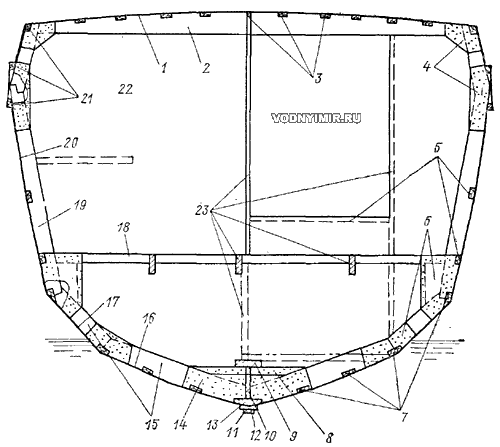
1 — deck flooring, plywood δ=3; 2 — beams 18x100; 3 — stringers 25x20; 4 — knits, plywood δ=6; 5 — side stringers, opening coaming, 25x20; 6 — knits, plywood δ=6; 7 — bottom and zygomatic stringers, 30x20; 8 — flora filler, 18x20; 9 — keelson 60x22; 10 — keelson filler, 120x22; 11 — falshkil 40x22; 12 — replaceable falshkil 35x22 with stainless steel shackle. steel 2x25; 13 — keel 70x22; 14 — knits flora, plywood δ=6; 15 — flor 50x18; 16 — bottom lining, plywood δ=6; 17 — zygomatic strip, plywood δ=6; 18 — rib 30x18; 19 — toptimbers 50x18; 20 — side lining, plywood δ=4; 21 — stringer 25x20; 22 — frame stitching, plywood δ=4; 23 — stiffener, pillars; 80x18. The whole set is made of pine.
In the section «Motorboats, boats, yachts — miscellaneous, reviews, tips»
Share this page in the social. networks or bookmark:
